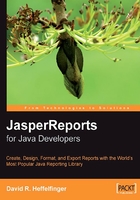
Conventions
In this book, you will find a number of styles of text that distinguish between different kinds of information. Here are some examples of these styles, and an explanation of their meaning.
There are three styles for code. Code words in text are shown as follows: "All JRXML files contain a<jasperReport> root element that can contain many sub-elements."
A block of code will be set as follows:
package net.ensode.jasperbook; import java.util.HashMap; import net.sf.jasperreports.engine.JREmptyDataSource; import net.sf.jasperreports.engine.JRException; import net.sf.jasperreports.engine.JasperFillManager;
When we wish to draw your attention to a particular part of a code block, the relevant lines or items will be made bold:
<detail>
<band height="20">
<staticText> <reportElement x="20" y="0" width="200" height="20"/> <text><! [CDATA[If you don't see this, it didn't work]]></text> </staticText>
</band>
</detail>
Any command-line input and output is written as follows:
$ ant
New terms and important words are introduced in a bold-type font. Words that you see on the screen, in menus or dialog boxes for example, appear in our text like this: "clicking the Next button moves you to the next screen".